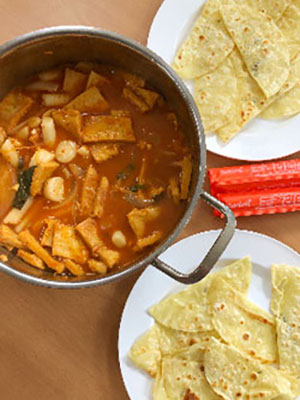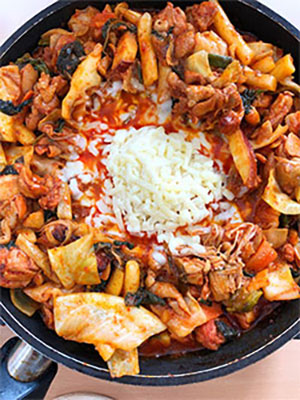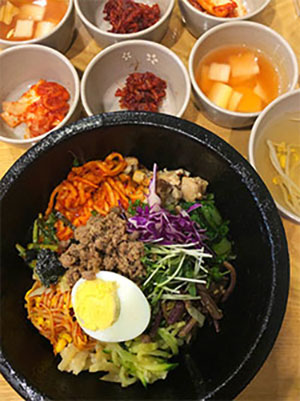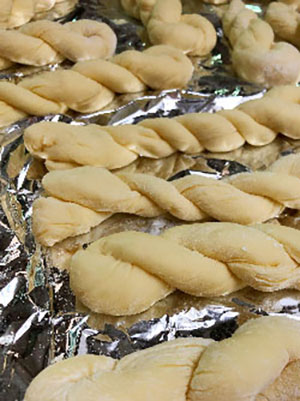
-
Exploring Korean Food Culture
Abigail Fox
“You learn a lot about someone when you share a meal together” - Anthony Bourdain.
As an avid Bourdain fan and wanna-be foodie, this quote has become a mantra that I repeat throughout my travels. Whether sharing a basket of flat-bread to scoop up hummus in Egypt or picking at thin slices of jamon serrano and salty olives on a terrace in Spain, I’ve found the conversations shared with locals to be equally as rich as the food. It is particularly true in Korea, where sharing a meal serves as a communal cultural experience. I moved to Daegu, South Korea in March of 2020 to teach English with the EPIK program. As an English as a Second Language (ESL) teacher, I was drawn to Korea for its impressive education system and enticed by its delicious cuisine. Due to the COVID-19 pandemic however, schools around the country were delayed in opening. For the past several months, we have been diligently preparing online materials and lessons for our students. I work in an office with five other teachers, two of which are my Korean co-teachers. Everyone has been extremely welcoming, but what truly solidified my relationships in the office is lunchtime! Every day, we pull out our homemade lunches and take time to talk with one another.
Though we are seated at our individual desks (1 meter apart per COVID-19 regulations), the conversation is lively and everyone makes an effort to include me. I love seeing all the dishes that people bring: kimchi jjigae (김치 찌개), a spicy soup made with kimchi and soft tofu;

Tteokbokki & Flat Mand

Dak-galbi
tteokbokki (떡볶이), stir-fried rice and fish cakes in a sweet & spicy chili sauce; a variety of banchan (반찬), small side dishes that accompany a meal. They delight in sharing stories and memories about these dishes that are part of Korea’s cultural heritage. Through these lunchtime conversations, I’ve learned a lot about Korean food culture.
For example, one day I noticed a teacher eating these flat, half-moon-shaped disks that I had never seen before. She told me they were called napchak mandu (납작만두), or flat mandu; mandu is the Korean version of a dumpling. Their flat shape comes from a lack of meat or vegetable stuffing which typically characterizes other dumplings. These are just the dumpling skins, folded and fried, often served with soy sauce and scallions. A specialty of Daegu, they originated in the 1960s when food was scarce and people needed a cheap lunch. Still a popular dish today, I rushed home after work to order napchak mandu from a food delivery service and I was not disappointed! In addition to knowledge about different types of dishes, I’ve picked up some Korean values and customs surrounding food. The value that most stands out is to waste nothing. That little bit of rice stuck to the bottom of the pot? Add hot water and make sungnyung (숭늉), a scorched rice tea. My co-teachers got a huge kick out of me calling it “rice water”! Or the odds and ends of vegetables that you’re planning to throw out; save them to make a flavorful soup stock. As a co-worker explained to me, less than 70 years ago (after the end of the Korean War), many Koreans were impoverished. As food was scarce, every little bit was put to use. That mentality stuck and most people today still try not to waste food; a value that I find both logical and admirable. I was also surprised to learn that communal dishes and the sharing of food are very common in Korea. It is customary to have a spread of dishes on a table to share amongst friends and family. You reach in with your chopsticks and take what you want, rather than portioning out each individual amount. For example, dak-galbi (닭갈비) is a popular spicy, stir-fried chicken and vegetable dish. Sometimes, gooey, melted cheese is placed in the center of the dish to offset the “tongue-on-fire” sensation from the gochujang sauce! Should you go to a restaurant with friends, you would be served one massive cast-iron skillet full of dak-galbi to share. I like the idea of sharing food with others, it creates a sense of community, rather than the “this is mine and that is yours” mentality you may experience in other countries.

Bibimbap

Kkwabaegi
I’ve also shared a lot about my culture (I’m from the U.S.A.) with my co-workers, who are equally as intrigued by my lunch choices as I am with theirs. They were shocked by my peanut butter and jelly sandwich: “isn’t that too sweet?” was the main concern. And impressed with my grilled cheese: “wow, so simple!” was the response. We talked about childhood nostalgia and comfort foods, about cultural differences and expectations, about a thousand different topics. Lunchtime has become an open forum for exchanging our unique stories and experiences; I look forward to it every day!
Inspired by my co-worker’s mouth-watering lunches, I decided to up my own lunch game from boring convenience store gimbap to homemade Korean dishes. A friend introduced me to a Korean cooking YouTube channel created by a woman named Maangchi. She is a Korean-American YouTuber and author who breaks down Korean cooking into easy-to-follow steps, in English! Immediately hooked by her bubbly and vivacious personality, I ordered a copy of her cookbook and began my cooking journey.
I’ve always loved to cook, but I’ll be honest, Korean cooking intimidated me. What was gochugaru (고춧가루) and how was I supposed to use it? Which soy sauce should I choose when there are 50 different types? These are just a few examples of the several thousand questions I have when shopping in a Korean grocery store. The cookbook broke it down for me, explaining the difference between types of rice and the uses of doenjang (된장), a fermented soybean paste.
I started small, making a simple bibimbap (비빔밥), a rice dish topped with an assortment of veggies and meat, and gradually progressed to more complex recipes like kkwabaegi (꽈배기), a twisted donut often sold by street-food vendors. My co-workers were extremely impressed when I brought in japchae (잡채), stir-fried glass noodles and vegetables, for lunch one day! I became excited to prepare my daily lunches and show-off what recipe I’d mastered. Though school has started now, so I no longer need to prepare my own lunch, I still look forward to preparing authentic Korean dishes for dinner and sharing my cooking experiences with my co-workers. Like the time I accidentally used gochujang (고추장) instead of doenjang (된장), making for an unexpected and extremely spicy soup!
Lunch with my co-workers provided me with an avenue through which to explore Korean culture and food. I feel like a respected and valued part of our small team and am looking forward to the school year ahead. And for the moment, once it is safe again, to finally eat together at the same table and share a meal! Geonbae (건배)! Cheers!
English Program in Korea(EPIK), Teach and Learn in Korea(TaLK)
National Institute for International Education Ministry of Education, Republic of Korea
191 Jeongjail-ro, Bundang-gu, Seongnam-si, Gyeonggi-do, 13557 Korea Tel : +82-2-3668-1400 Fax: +82-2-764-1328
National Institute for International Education Ministry of Education, Republic of Korea
191 Jeongjail-ro, Bundang-gu, Seongnam-si, Gyeonggi-do, 13557 Korea Tel : +82-2-3668-1400 Fax: +82-2-764-1328


